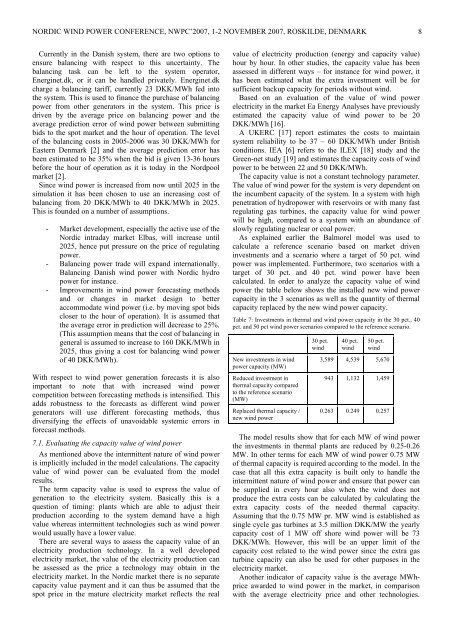50 pct. Wind Power in Denmark and Power ... - Ea Energianalyse
50 pct. Wind Power in Denmark and Power ... - Ea Energianalyse
50 pct. Wind Power in Denmark and Power ... - Ea Energianalyse
You also want an ePaper? Increase the reach of your titles
YUMPU automatically turns print PDFs into web optimized ePapers that Google loves.
NORDIC WIND POWER CONFERENCE, NWPC’2007, 1-2 NOVEMBER 2007, ROSKILDE, DENMARK 8Currently <strong>in</strong> the Danish system, there are two options toensure balanc<strong>in</strong>g with respect to this uncerta<strong>in</strong>ty. Thebalanc<strong>in</strong>g task can be left to the system operator,Energ<strong>in</strong>et.dk, or it can be h<strong>and</strong>led privately. Energ<strong>in</strong>et.dkcharge a balanc<strong>in</strong>g tariff, currently 23 DKK/MWh fed <strong>in</strong>tothe system. This is used to f<strong>in</strong>ance the purchase of balanc<strong>in</strong>gpower from other generators <strong>in</strong> the system. This price isdriven by the average price on balanc<strong>in</strong>g power <strong>and</strong> theaverage prediction error of w<strong>in</strong>d power between submitt<strong>in</strong>gbids to the spot market <strong>and</strong> the hour of operation. The levelof the balanc<strong>in</strong>g costs <strong>in</strong> 2005-2006 was 30 DKK/MWh for<strong>Ea</strong>stern <strong>Denmark</strong> [2] <strong>and</strong> the average prediction error hasbeen estimated to be 35% when the bid is given 13-36 hoursbefore the hour of operation as it is today <strong>in</strong> the Nordpoolmarket [2].S<strong>in</strong>ce w<strong>in</strong>d power is <strong>in</strong>creased from now until 2025 <strong>in</strong> thesimulation it has been chosen to use an <strong>in</strong>creas<strong>in</strong>g cost ofbalanc<strong>in</strong>g from 20 DKK/MWh to 40 DKK/MWh <strong>in</strong> 2025.This is founded on a number of assumptions.- Market development, especially the active use of theNordic <strong>in</strong>traday market Elbas, will <strong>in</strong>crease until2025, hence put pressure on the price of regulat<strong>in</strong>gpower.- Balanc<strong>in</strong>g power trade will exp<strong>and</strong> <strong>in</strong>ternationally.Balanc<strong>in</strong>g Danish w<strong>in</strong>d power with Nordic hydropower for <strong>in</strong>stance.- Improvements <strong>in</strong> w<strong>in</strong>d power forecast<strong>in</strong>g methods<strong>and</strong> or changes <strong>in</strong> market design to betteraccommodate w<strong>in</strong>d power (i.e. by mov<strong>in</strong>g spot bidscloser to the hour of operation). It is assumed thatthe average error <strong>in</strong> prediction will decrease to 25%.(This assumption means that the cost of balanc<strong>in</strong>g <strong>in</strong>general is assumed to <strong>in</strong>crease to 160 DKK/MWh <strong>in</strong>2025, thus giv<strong>in</strong>g a cost for balanc<strong>in</strong>g w<strong>in</strong>d powerof 40 DKK/MWh).With respect to w<strong>in</strong>d power generation forecasts it is alsoimportant to note that with <strong>in</strong>creased w<strong>in</strong>d powercompetition between forecast<strong>in</strong>g methods is <strong>in</strong>tensified. Thisadds robustness to the forecasts as different w<strong>in</strong>d powergenerators will use different forecast<strong>in</strong>g methods, thusdiversify<strong>in</strong>g the effects of unavoidable systemic errors <strong>in</strong>forecast methods.7.1. Evaluat<strong>in</strong>g the capacity value of w<strong>in</strong>d powerAs mentioned above the <strong>in</strong>termittent nature of w<strong>in</strong>d poweris implicitly <strong>in</strong>cluded <strong>in</strong> the model calculations. The capacityvalue of w<strong>in</strong>d power can be evaluated from the modelresults.The term capacity value is used to express the value ofgeneration to the electricity system. Basically this is aquestion of tim<strong>in</strong>g: plants which are able to adjust theirproduction accord<strong>in</strong>g to the system dem<strong>and</strong> have a highvalue whereas <strong>in</strong>termittent technologies such as w<strong>in</strong>d powerwould usually have a lower value.There are several ways to assess the capacity value of anelectricity production technology. In a well developedelectricity market, the value of the electricity production canbe assessed as the price a technology may obta<strong>in</strong> <strong>in</strong> theelectricity market. In the Nordic market there is no separatecapacity value payment <strong>and</strong> it can thus be assumed that thespot price <strong>in</strong> the mature electricity market reflects the realvalue of electricity production (energy <strong>and</strong> capacity value)hour by hour. In other studies, the capacity value has beenassessed <strong>in</strong> different ways – for <strong>in</strong>stance for w<strong>in</strong>d power, ithas been estimated what the extra <strong>in</strong>vestment will be forsufficient backup capacity for periods without w<strong>in</strong>d.Based on an evaluation of the value of w<strong>in</strong>d powerelectricity <strong>in</strong> the market <strong>Ea</strong> Energy Analyses have previouslyestimated the capacity value of w<strong>in</strong>d power to be 20DKK/MWh [16].A UKERC [17] report estimates the costs to ma<strong>in</strong>ta<strong>in</strong>system reliability to be 37 – 60 DKK/MWh under Britishconditions. IEA [6] refers to the ILEX [18] study <strong>and</strong> theGreen-net study [19] <strong>and</strong> estimates the capacity costs of w<strong>in</strong>dpower to be between 22 <strong>and</strong> <strong>50</strong> DKK/MWh.The capacity value is not a constant technology parameter.The value of w<strong>in</strong>d power for the system is very dependent onthe <strong>in</strong>cumbent capacity of the system. In a system with highpenetration of hydropower with reservoirs or with many fastregulat<strong>in</strong>g gas turb<strong>in</strong>es, the capacity value for w<strong>in</strong>d powerwill be high, compared to a system with an abundance ofslowly regulat<strong>in</strong>g nuclear or coal power.As expla<strong>in</strong>ed earlier the Balmorel model was used tocalculate a reference scenario based on market driven<strong>in</strong>vestments <strong>and</strong> a scenario where a target of <strong>50</strong> <strong>pct</strong>. w<strong>in</strong>dpower was implemented. Furthermore, two scenarios with atarget of 30 <strong>pct</strong>. <strong>and</strong> 40 <strong>pct</strong>. w<strong>in</strong>d power have beencalculated. In order to analyze the capacity value of w<strong>in</strong>dpower the table below shows the <strong>in</strong>stalled new w<strong>in</strong>d powercapacity <strong>in</strong> the 3 scenarios as well as the quantity of thermalcapacity replaced by the new w<strong>in</strong>d power capacity.Table 7: Investments <strong>in</strong> thermal <strong>and</strong> w<strong>in</strong>d power capacity <strong>in</strong> the 30 <strong>pct</strong>., 40<strong>pct</strong>. <strong>and</strong> <strong>50</strong> <strong>pct</strong> w<strong>in</strong>d power scenarios compared to the reference scenario.New <strong>in</strong>vestments <strong>in</strong> w<strong>in</strong>dpower capacity (MW)Reduced <strong>in</strong>vestment <strong>in</strong>thermal capacity comparedto the reference scenario(MW)Replaced thermal capacity /new w<strong>in</strong>d power30 <strong>pct</strong>.w<strong>in</strong>d40 <strong>pct</strong>.w<strong>in</strong>d<strong>50</strong> <strong>pct</strong>.w<strong>in</strong>d3,589 4,539 5,670943 1,132 1,4590.263 0.249 0.257The model results show that for each MW of w<strong>in</strong>d powerthe <strong>in</strong>vestments <strong>in</strong> thermal plants are reduced by 0.25-0.26MW. In other terms for each MW of w<strong>in</strong>d power 0.75 MWof thermal capacity is required accord<strong>in</strong>g to the model. In thecase that all this extra capacity is built only to h<strong>and</strong>le the<strong>in</strong>termittent nature of w<strong>in</strong>d power <strong>and</strong> ensure that power canbe supplied <strong>in</strong> every hour also when the w<strong>in</strong>d does notproduce the extra costs can be calculated by calculat<strong>in</strong>g theextra capacity costs of the needed thermal capacity.Assum<strong>in</strong>g that the 0.75 MW pr. MW w<strong>in</strong>d is established ass<strong>in</strong>gle cycle gas turb<strong>in</strong>es at 3.5 million DKK/MW the yearlycapacity cost of 1 MW off shore w<strong>in</strong>d power will be 73DKK/MWh. However, this will be an upper limit of thecapacity cost related to the w<strong>in</strong>d power s<strong>in</strong>ce the extra gasturb<strong>in</strong>e capacity can also be used for other purposes <strong>in</strong> theelectricity market.Another <strong>in</strong>dicator of capacity value is the average MWhpriceawarded to w<strong>in</strong>d power <strong>in</strong> the market, <strong>in</strong> comparisonwith the average electricity price <strong>and</strong> other technologies.
















